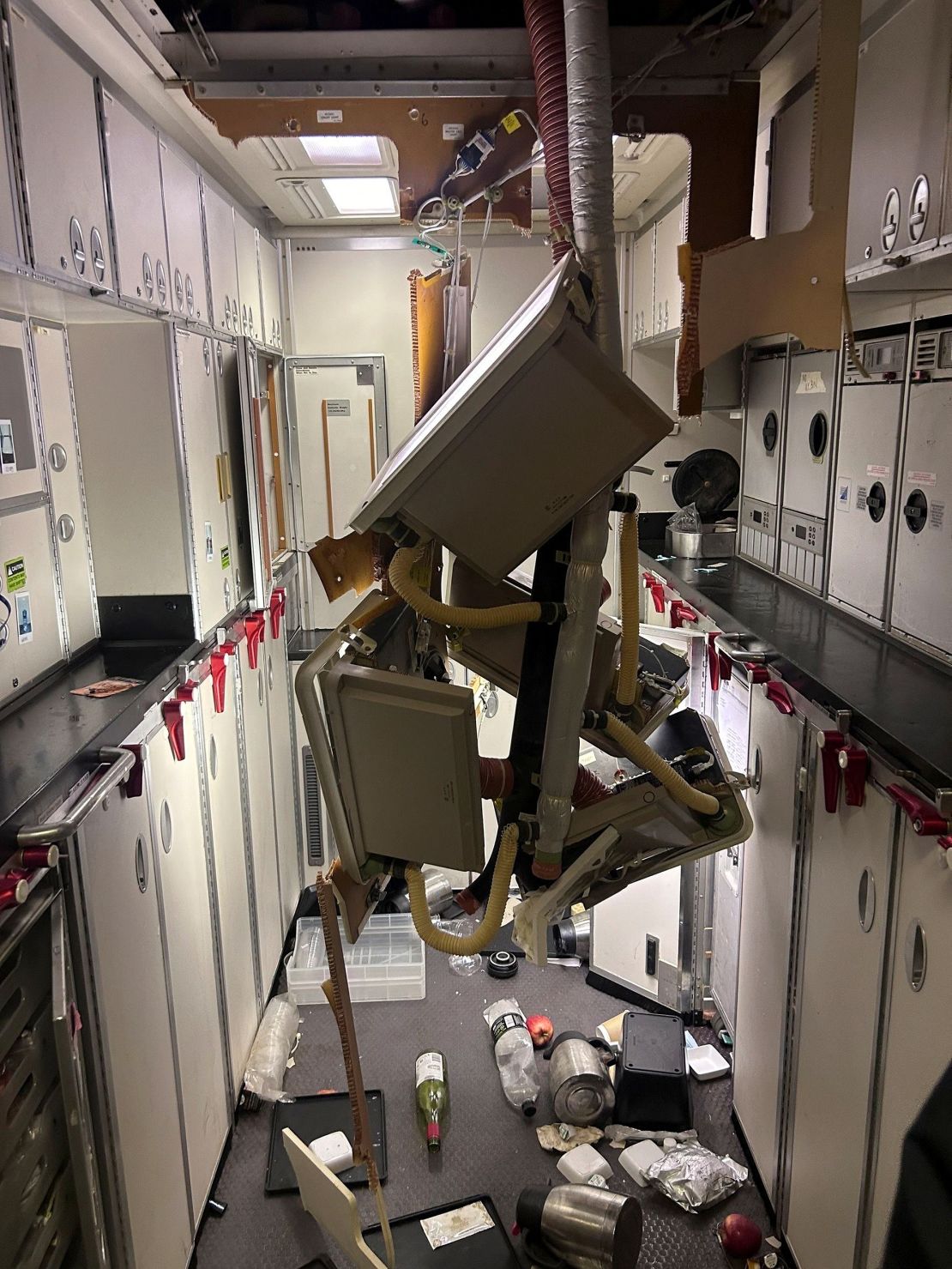The incident occurred during a flight from Singapore to London.
On Tuesday, a violent turbulence threw passengers and staff about the cabin of their Singapore Airlines aircraft from London to Singapore, resulting in one passenger’s death and 71 injuries. The jet was forced to make an emergency landing in Bangkok.
According to the airline, the Boeing 777-300ER encountered turbulence when passing over Myanmar’s Irrawaddy Basin around ten hours into the journey and halfway through supper service.
Business traveler Andrew Davies, who was on aircraft SQ321, told Erin Burnett that the flight had been “absolutely regular” until the seatbelt indicator illuminated, at which point “all hell broke out.”
“It felt like the plane fell.” Though it was probably short lived, I still clearly recall seeing shoes, iPads, iPhones, blankets, cushions, silverware, plates, and glasses flying through the air and hitting the ceiling. “The man sitting behind me spilled a cup of coffee all over me and up to the ceiling,” Davies remarked.
After describing multiple people with gashes on their heads, including one with “blood running down her face” and an elderly passenger in “serious shock,” Davies claimed to have recognized the “gravity” of the turbulence when he turned back.
He said, “There was a lot of shouting.”
The magnitude of the devastation was visible in photos and videos taken inside the airplane, where emergency oxygen masks were suspended from the ceiling and overhead compartments were completely destroyed. A picture of a particular galley featured an exposed ceiling with pieces of the aircraft’s interior dangling below. There are trays, containers, pots for hot beverages, and plastic bottles scattered all over the floor.
The event claimed the life of a 73-year-old British man who had a suspected cardiac ailment, according to Kittipong Kittikachorn, General Manager of Suvarnabhumi International Airport in Bangkok. The autopsy is still being conducted, Kittipong said on Tuesday.
The individual was later identified as Geoff Kitchen, who worked with the Thornbury Musical Theatre Group (TMTG) for more than 35 years. The group characterized Kitchen as “always a gentleman with the utmost honesty and integrity.”
The British Foreign Office is offering help to the family of a British traveler who lost their life on a Singapore Airlines flight.
Seated toward the front of the aircraft, Davies claimed to have assisted in tending to Kitchen, who was seated behind him.
“Several individuals required assistance, but we attended to one man, and I assisted in moving him, removing him from the seat, and placing him on the ground so that medical professionals could perform CPR,” Davies stated. The passenger received CPR for almost 20 minutes.
The passenger received CPR for almost 20 minutes but, unfortunately, did not survive.
Six of the injured passengers had significant injuries, according to the Samitivej Srinakarin Hospital in Bangkok, where at least 71 people were treated. Citizens of Malaysia, the UK, New Zealand, Spain, the US, and Ireland are among those injured.
According to Kittikachorn, who examined the plane, some of the injured passengers had fractured arms.
Online flight monitors indicate that the aircraft, which was carrying 211 passengers and 18 crew members, took off from London’s Heathrow Airport at approximately 10:30 p.m. local time. The flight was headed for Changi Airport in Singapore, but the airline reports that it was redirected to Bangkok, where it touched down at 3:45 p.m. local time.
A passenger is seen being removed from Singapore Airlines SQ321 on a stretcher by emergency personnel in a video that was captured after the plane was diverted to Bangkok.
Almost 200 passengers were waiting to board subsequent planes to their destinations in Bangkok, according to Kittikachorn. He said that 131 of the 211 passengers were on a Singapore Airlines flight that later left Bangkok for Singapore.
According to a statement from Singapore Airlines CEO , Goh Choon Phong, the company is “offering all available assistance and support” to travelers and their families.
“I would like to extend my sincere sympathies to the family and loved ones of the deceased passenger on behalf of Singapore Airlines. He said, “We also sincerely apologize for the trauma that all of the passengers and staff members went through on this flight.
The US National Transportation Safety Board is sending staff to Singapore to assist with the probe, according to a statement from Singapore’s Ministry of Transport, which is looking into the circumstances surrounding aircraft SQ321.

The aircraft most likely met quickly intensifying thunderstorms.
As an aircraft passes between colliding air masses traveling at drastically different speeds, turbulence results.
Passengers may feel pressure from their seatbelts in mild to moderate turbulence, and loose objects may fly around the cabin. But, under extreme circumstances, turbulence can fling occupants around the cabin, leading to serious injuries and occasionally fatalities.
The aircraft “encountered abrupt extreme turbulence over the Irrawaddy Basin [a river in Myanmar] at 37,000 feet, roughly 10 hours after takeoff,” according to a statement from the airline.
FlightRadar24, an aviation tracking website, shows that the aircraft made a sharp drop and quickly climbed several hundred feet before diving and climbing once more before eventually settling back at its cruise level. Based on the statistics, the entire disruption lasted for approximately ninety seconds.
After roughly 14 minutes, the airplane alters its trajectory. “The pilot reported a medical emergency and redirected the plane to Bangkok,” the airline stated.
Our analysis indicates that during the period of significant turbulence reported on Tuesday, the flight most likely met quickly, forming thunderstorms over southern Burma.
These kinds of tropical thunderstorms are normal for this time of year, when South Asia’s southwest monsoon season is just getting started and the area’s moisture content is rising. As the land warms in the early afternoon, they can form quickly, especially in areas close to the coast.
Early on in their development, developing thunderstorms like Tuesday’s might not show up on radar, but the rapidly rising motion within them can still cause turbulence. In less than an hour, the storm cells probably expanded from 20,000–30,000 feet to well over 50,000 feet.
There could be more turbulence.
It’s always best to err on the side of caution and avoid flying near these storms.
Each year in the United States, over 65,000 aircraft experience moderate turbulence, and roughly 5,500 experience severe turbulence. Nevertheless, an atmospheric science professor at the University of Reading in the United Kingdom suggests that these figures may be set to rise as the climate crisis modifies turbulence.
According to a September 2022 study, by 2050–2080, clear-air turbulence will grow dramatically worldwide, especially along the busiest flight routes, with the strongest type of turbulence experiencing the greatest increase.
A former White House staffer died in March 2023 as a result of erratic maneuvers on a private plane; however, an inquiry subsequently determined that weather had no role in the occurrence. That incident happened only a few days after a separate commercial flight experienced severe turbulence, resulting in the hospitalization of seven people.
Thirty-six individuals were rushed to emergency rooms after a Hawaiian Airlines flight from Arizona to Honolulu in December 2022 suffered 36 injuries, including strong turbulence that buffeted the aircraft in July 2023, injuring seven people.
One of the safest airlines in the world is frequently regarded as Singapore Airlines.
The only other tragic accident that occurred there was on October 6, 2000, when the Boeing 747-400 on flight SQ006 crashed into the heavy rain as it took off from a restricted runway in Taiwan, killing all 83 people on board.
In a subsequent Tuesday statement on its Facebook page, Singapore Airlines stated that a committed team had arrived in Bangkok “to support our staff and the local authorities on the ground.”
“Deepest sympathies to the relatives of the deceased,” the aircraft operator said. We sincerely regret the horrific ordeal that both our passengers and crew went through on this trip.
According to Boeing, the Singaporean airline is in contact with them, and they are “ready for support.” Further inquiries are being referred by the manufacturer to the airline and local law enforcement.
Further developments have been added to this story and headline.
Correction
An earlier version of this article included an inaccurate account of an event involving a private jet in March 2023. The National Transportation Safety Board subsequently concluded that the plane’s abrupt movements were unrelated to the weather.
________________________________________________________________________________________________________



